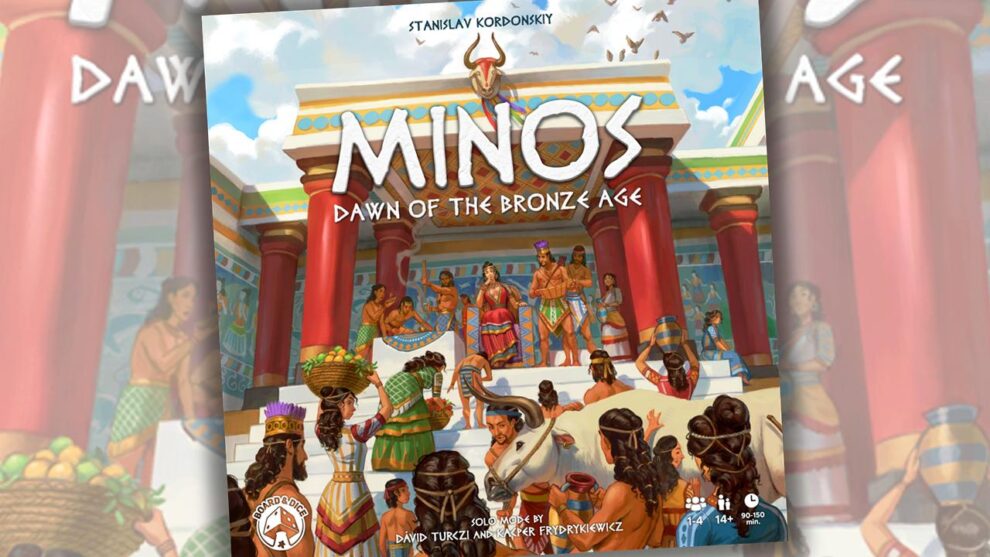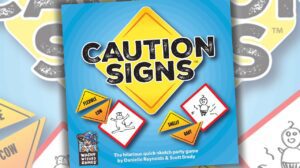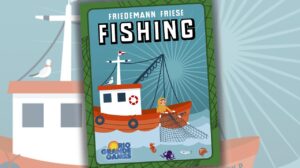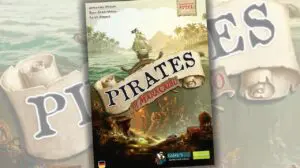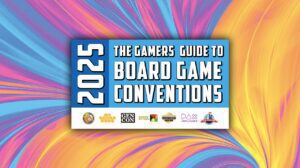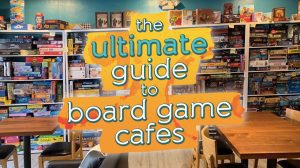Disclosure: Meeple Mountain received a free copy of this product in exchange for an honest, unbiased review. This review is not intended to be an endorsement.
2024 was an exceptional year for the medium- to medium-heavy weight strategy game category.
I reviewed almost a dozen of them, including SETI: Search for Extraterrestrial Intelligence, Windmill Valley, Daitoshi, Reef Project, Andromeda’s Edge, Asian Tigers: A Story of Prosperity, Pirates of Maracaibo, Shackleton Base: A Journey to the Moon, and many others. (And those were all from just the final five months of last year!)
In that vein, Board&Dice’s big 2024 fall release was Minos: Dawn of the Bronze Age. Board&Dice gets it right more often than not, with solid entries from their catalog such as Teotihuacan: City of Gods, Tiletum, and Nucleum all ranking in the BGG top 300 or so as of this posting. Minos had a lot of hype coming into Essen SPIEL last fall, and now that I have completed three plays (one each at three, four, and solo player counts), I have some thoughts.
Here’s the short version: play it, but don’t bring many friends!
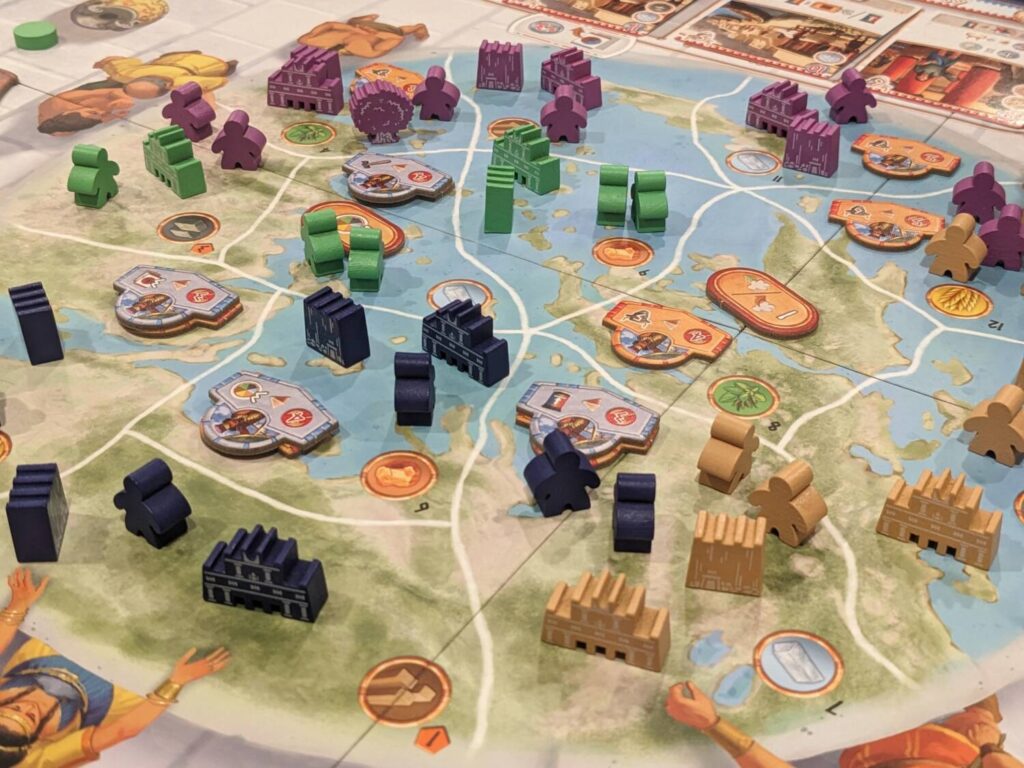
Baby’s First Coimbra
Minos: Dawn of the Bronze Age is a 1-4 player dice drafting, area control game with a series of tracks that grant the players a wide range of combo-tastic actions. The game was designed by Stan Kondonskiy (Endless Winter: Paleoamericans) and features a theme that positions players as leaders of clans trying to win the hearts and minds of the Minoan people in ancient times.
The core mechanic of Minos is a dice drafting system. In each of the game’s four rounds, a series of dice are rolled, then players take turns drafting a single die and place it in a cute die holder (almost identical to the physical dynamic offered in the game Coimbra). Then the die and its holder are placed on one of the game’s five action areas, if there is any room left for that die. Later, drafted dice will be used to boost a player’s position on certain tracks.
As die holders are placed on action areas, they are re-ranked immediately based on pip value—the lower the value, the better the action in each area. (For example, going earlier in the Build action area means that a player gets more action points to build cities, walls, boats, and farms.) But drafting high-value dice gives players a much easier chance to collect sets that are used to boost up one or two tracks each round, which grant all kinds of in-game bonuses. (Unlike Coimbra, where high value dice could be bumped out of position to take an action aligned with the row where it was placed earlier in a round, Minos isn’t quite as mean.)
I love the dice drafting tension here. It was a blast to figure out ways to build the sets I needed to trigger the track boosts. Then I had to find ways to use those selections to take actions that were reasonable enough to accomplish my goals, especially when drafting high-pip dice to do anything of value. The dice come in three colors (red, yellow, blue), aligned with the three main tracks in the game that boost income, building efficiency and military/area control powers, respectively. A fourth die color (gray) is wild, and can be used to provide flexibility during set collection, but there are a limited number of gray dice each round.
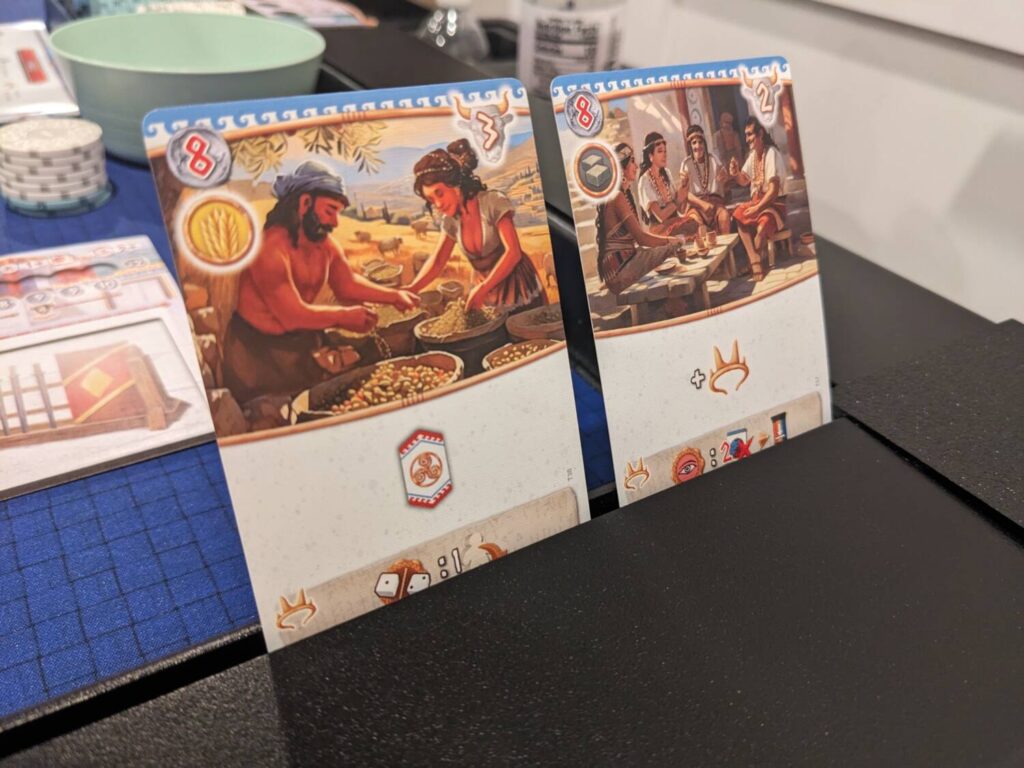
So, the first phase of each round was juicy. (It was even juicier during my four-player game, when I had a special power that allowed me to move up tracks when I had access to a lower pip value threshold.) Where Minos may—or may not—stumble is based purely on the most important qualifier of this game: your player count.
This is mainly because of the round structure. In turn order, the active player “releases” (activates) their highest value die, which is usually aligned with the least valuable action, assuming there was competition in that action area. That alone leads to a wild series of experiences—one player might take the “worst” build action, then another player takes the worst card-drafting action, then the next player might take the only wild action of the round, and so on.
Players are executing actions that might be out of order for their original plans; what if their highest-value die is in the Build action area, but they can’t build everything they want yet because they need to take the Expand action first, allowing them to move warriors around the map? What if you wanted to take that Build action, but you were certain that the action would end up in the middle of that action point area, and now as the holder of the last space, you have less points to complete the action because your neighbor slid a lower-value die in front of yours?
The timing considerations of action execution in Minos ended up being fascinating. I was less of a fan during my first play, but as I did my third play (the solo game), I found myself much more able to plan around which specific die should be played and in which order to achieve my dreams. (There is also less chaos in the solo/two-player game, which I think is a benefit to the game’s design.)
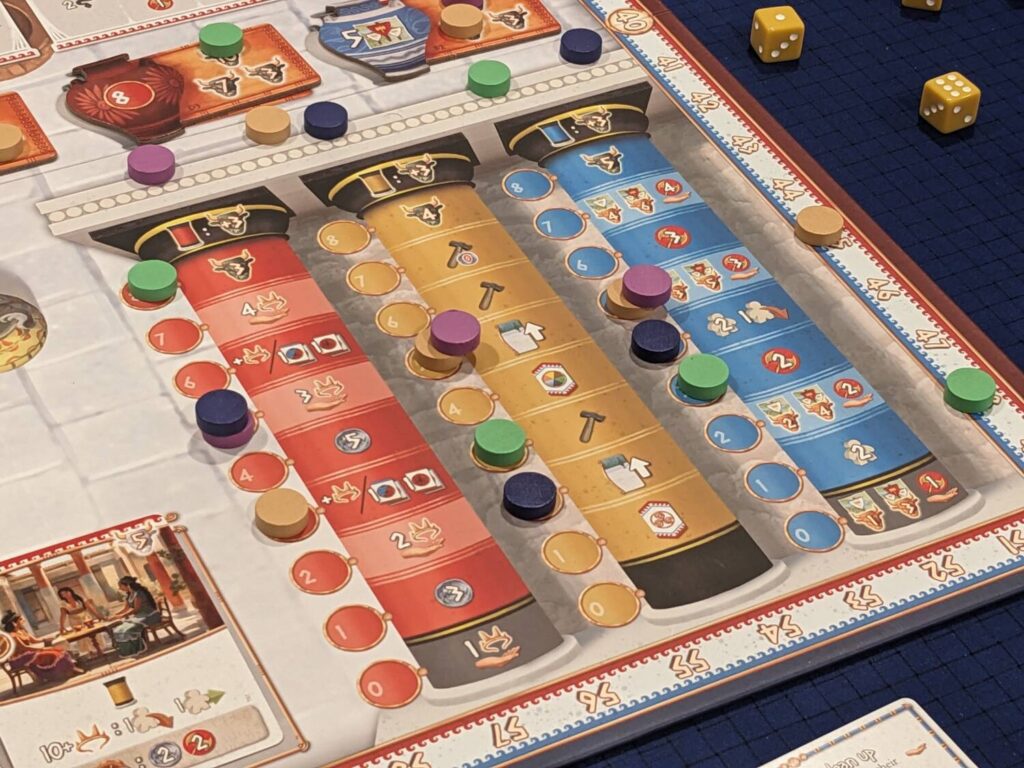
The Core Gameplay
The actions themselves? Fairly vanilla. You can build structures and move warriors around a small map centrally located on the main board. There’s a wild action space to let you do any of the four other main actions, at a diminished strength. One action lets you draft Decree cards, as many as four of them on a turn. Minos uses a goods system that operates like the tag discount system of other games such as Terraforming Mars. Each Decree card has a straight-up cost in coins, which can be reduced if you possess (not spend, just possess) certain goods symbols in your tableau area. Other ongoing powers may reduce the card costs further.
But this drafting action doesn’t allow a player to play cards…only draft them. A separate action allows a player to play those cards to the table. This separation, making the card draft and the card play two separate actions, feels extraneous. Minos is a game that features 16 action turns per player on top of the dice-drafting phases. It’s one step too many, especially in a game that features this many combos.
Let’s talk card play for a moment, because while each round of Minos starts with a dice draft, this is ultimately a card game. First, pro tip: sit as close as you can to the five-card market area of the main board, because you are going to need to absorb a lot of information from that area. Each card has a point value that is earned if a card is tucked into your “Palace” by the end of the game. (The Palace is the area underneath your player board.) Each card has a main action when played from hand to the table, then cards are added later to the Palace during end-of-round income steps.
Each card has a cost, and each card, when tucked, grants an ongoing power triggered by either an action taken by the owner, or by the pip value of the die used to take an action. An experienced player will use this information to build an engine that triggers a series of combos that splits the line between owner satisfaction (“my engine is dope”) and opponent outrage (“Now I have to watch Kev run his seven-card bonus action combo BEFORE he takes his main turn.”)
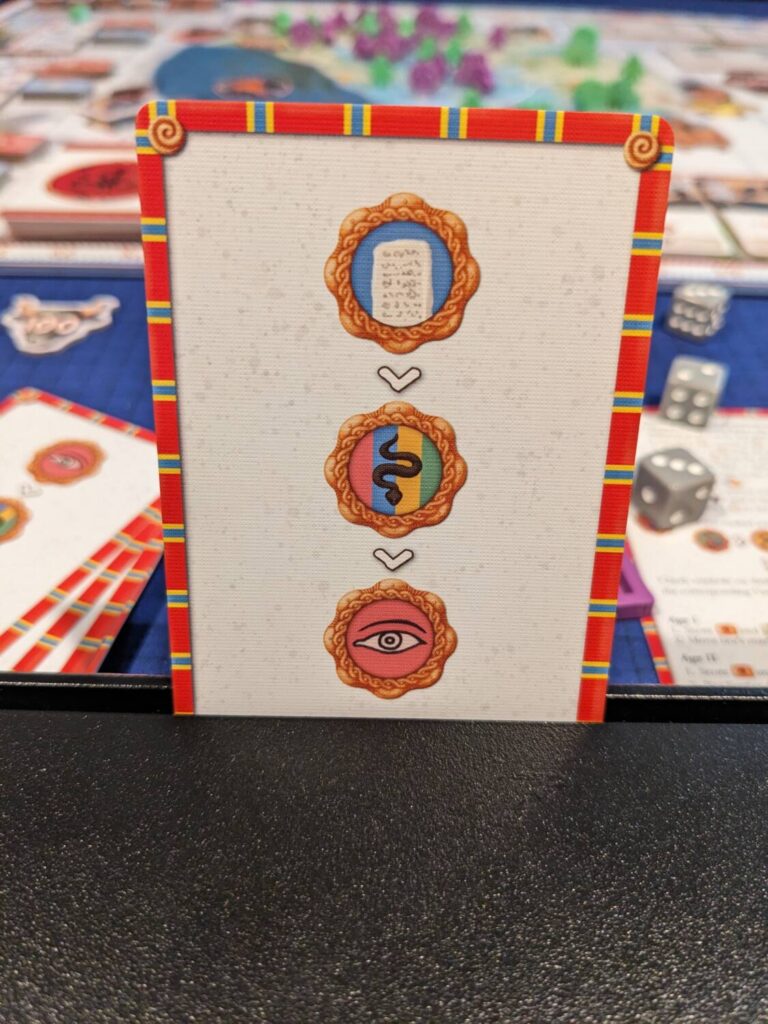
In a two-player game, I have a feeling this will be fantastic; only one person is waiting on me as I take a 5-7 minute turn. (Or, in my case, no one waiting on me, in the solo mode that mimics the two-player experience.) In a four-player game, it turned our experience into a three-and-a-half-hour slugfest, where I really did spend about 80% of the game NOT taking turns.
The downtime here is not what dreams are made of.
I played Minos with fast players, particularly in my three-player game. Doesn’t matter, folks. There are just a lot of steps to each turn, complicated with an extra actions dynamic that gives each player a chance to take up to six separate bonus actions EVERY TURN. (Ahh, yes, I didn’t mention this part…in addition to the combos triggered by tucked cards, players are highly encouraged to take up to six different free actions every turn in addition to the bonus actions triggered by cards. The player aids, which are excellent, highlight this fact with an orange bar on the Extra Actions side of one of the aids.)
The cards add many, possibly dozens, of additional actions, and the second half of my multiplayer games of Minos featured so many combos that I often lowered my head in pain, waiting for everyone else to finish turns. I found myself wishing Minos was a 12-turn game, and not a 16-turn game, because I didn’t learn much about the game, the mechanics, or myself when the game badly overstayed its welcome.
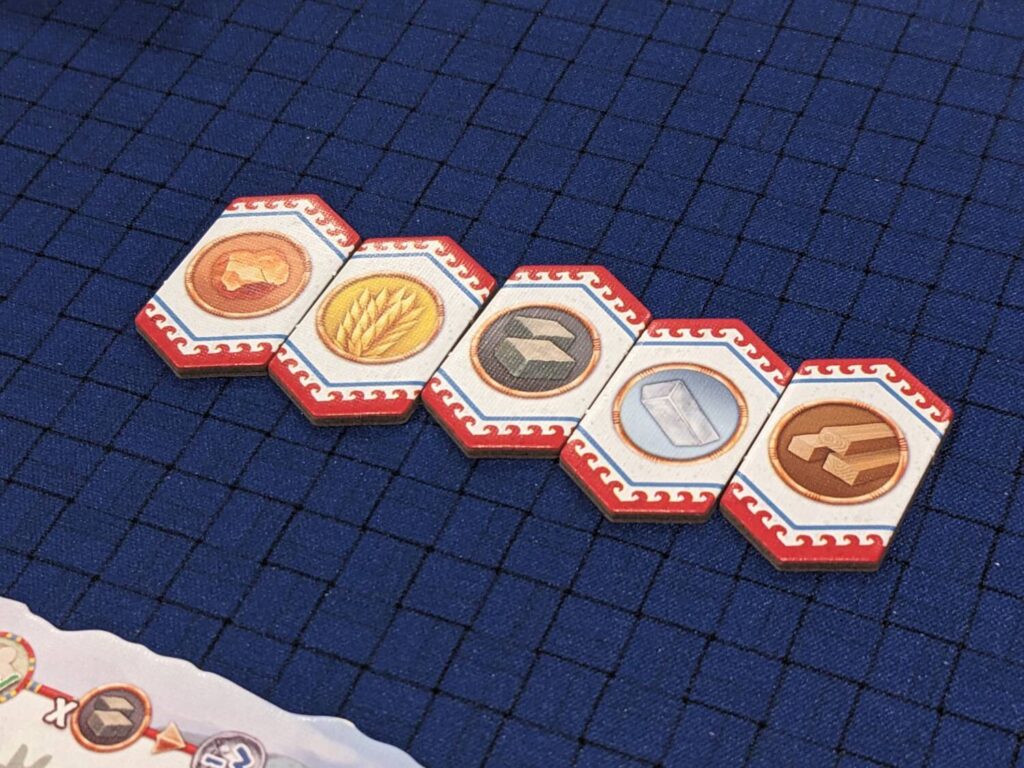
Wait, It’s an Area Control Game Too?
For just a little while—specifically, at the end of the eighth and 16th turns—Minos becomes an area control game.
Minos isn’t an area control game in the way you are thinking, especially if you are like me and have played a lot of “fighty” 4X-adjacent games. Minos features four different units—cities, farms, boats, and warriors. But the area control scoring only values warriors, so all the other building types are worthless when area control scoring is tallied. (One type, farms, offers a blanket score based on the number of farms on the map. But they are not factored into area majorities.)
Also, players can move warriors anywhere they want during a round as long as they have the action points and resources to spend during their dice resolution actions, and players can even build structures in places where other faction units exist.
Some of these rules are a sizable change from nearly every area control game I can think of. Leaving one of the exploration map’s 10 regions with only cities, for example, means that no player scores that region. Every player that has at least one warrior in a region scores for presence, while having the single-most warriors in a region scores dominance points. Regions that don’t have any warrior units don’t score.
This does provide an interesting series of turns leading up to the area control scoring, as players take the Expand action to move warriors to different regions to try and achieve dominance. Grabbing the first spot in the Expand action in the second and fourth rounds was extremely consequential, so savvy players caught on by the end of each play and tried to ensure they could move their units last to claim majorities.
But the area control scoring does make Minos seem like a game that tried hard to have it all in a game that probably didn’t need it. Minos is a tableau-building, Euro-style tracks game, not a battling/war/dominance game. I’m all for ambition in the design of games like this, but Minos doesn’t take as many steps to make it all fit the way dedicated 4X games like Brazil: Imperial, Scythe, or Voidfall accomplished with their designs.
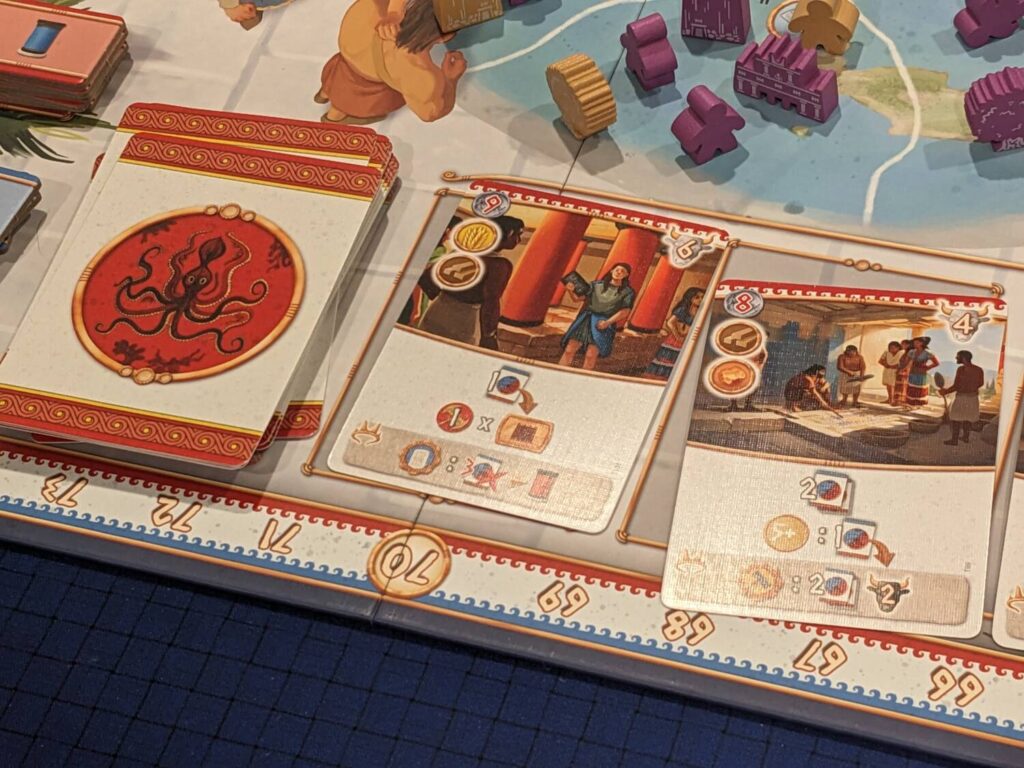
Still, There’s Something Here
Minos: Dawn of the Bronze Age does a fantastic job of setting up each four-turn round with its clever, thinky dice drafting mechanic. In fact, that’s the main reason I will hold onto my review copy. I will also stick with a lower player count; four players was a miss, but I really enjoyed my solo play and I think this is a two-hour game with three players who know their way around. (Big shout out to the solo gameplay here, which is very easy to administer even if it feels like the bot has too easy of a time spreading itself out with warriors on the map.)
Between the dozens of unique cards and the different milestones available in each game, Minos has a nice amount of setup variability to keep players coming back. Note that setup can be steep, not because of the component layout but because of the pre-game choices required of each player. Everyone gets to draft a player-specific power, then sort through a hand of 5-7 cards to determine which 2-3 cards they will keep. Each player starts with a random good, so that helps steer a player towards keeping certain cards in their hand, but then each player gets to tuck one of their Decree cards to give them a bonus power for the entire game.
These steps are interesting, but it does add 10-15 minutes to the start up. Some of these decisions can also prove consequential, so deliberate players will take more time than others to make these initial decisions to get rolling. This is another reason why Minos, in the wrong hands and with a high player count, might overstay its welcome.
One player in my multiplayer games noted that Minos felt a bit “point salad-y”, which I agree with now that I’ve finished a few games. I scored 147 points in my first game and finished a distant third to a player who scored 221 points. And it was clear that the game was well out of reach by the end of the third round (so, by the 12th turn). I don’t think Minos has a runaway leader problem—while the game was out of reach, different decisions would close the gap quickly, especially now that I know Minos is first and foremost a goods-driven card game. But 147 sounds like I did well, right? I would argue that I played the game quite badly and I still scored almost 150 points.
But there are lots of ways to earn a point here or two points there, especially with tucked cards in a player’s Palace or by getting a small bonus simply for taking an action from the dice placement area. Whenever a game has no tiebreaker—and Minos does not have a tiebreaker—I know we are in point salad territory!
I only have one real negative: boats. I haven’t even mentioned this item from the Build menu because it just never got me excited. Boats can be built then launched up one of three different tracks that grant the boat’s owner increased income between rounds, as well as grant the boat’s owner bonus tiles that can be taken as additional actions.
In a game that already has tons of bonus actions, I’m not sure Minos needed more ways to trigger more actions. I found boats to be most interesting when I had already built all my other buildings, and needed something to do with the Build action late in the game if other actions were blocked. But no one specialized in boats across my three plays and I would be shocked if regular Minos players found that building and advancing boats as a primary strategy offered a consistent path to victory.
Otherwise, I found Minos: Dawn of the Bronze Age to be a fun time at the table. I recommend this for fast decision makers who typically play with one or two of the same people on a regular basis. It’s an easy teach for experienced hobbyists and the cardplay is a lot of fun. Board&Dice once again smoked this production; the player boards, the card stock, the look and feel of the board, the color palette, the player aids and the set-up options all work well. Fans of dice-drafting games should give Minos a look!


